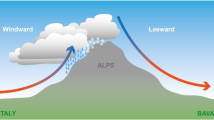Abstract
Background
Our objective is to identify seasonal and weather trends associated with pediatric trauma admissions.
Methods
We reviewed all trauma activations leading to admission in patients ≤18 years admitted to a regional pediatric trauma center from January 1, 2000, to December 31, 2015. We reviewed climatologic measures of the mean temperature, mean visibility, and precipitation for each admission in the 6 h prior to each presentation in addition to time of arrival, weekday/weekend presentation, and season. We used a negative binomial regression model with multivariable analysis to estimate associations between weather and rate of trauma admissions. Results were presented as incidence rate ratios (IRR) with 95% confidence intervals (CI).
Results
In total, 3856 encounters [2539 males (65.8%), mean age 10.2 years ± SD 5.1 years] were included. Results from multivariable analysis (IRR, 95% CI) suggested an association of admissions with rain (0.82, 0.75–0.90) and overnight hours (23:51–05:50; 0.69, 0.58–0.82) as compared to morning (05:51–11:50). The IRR of trauma increased during the afternoon (11:51–17:50; 4.05, 3.57–4.61), night periods (17:51–23:50; 5.59, 4.94–6.33), and weekends (1.24, 1.15–1.32), and with every 1 °C increase in temperature (1.04, 1.03–1.04). After accounting for other variables, season was not found to be independently predictive of trauma admission.
Conclusion
Trauma admissions had a higher rate during afternoon, evening hours, and weekends. The presence of rain lowered the rate of pediatric trauma admission. Each degree increase in temperature increased the rate of trauma admissions by 4%. The findings provide information from the perspective of emergency preparedness, resource utilization, and staffing to pediatric trauma centers.


Similar content being viewed by others
References
Centers for Disease Control and Prevention: National Center for Injury Prevention and Control Web-based Injury Statistics Query and Reporting System (WISQARS). https://www.cdc.gov/injury/wisqars/fatal.html. Accessed 28 June 2018
Wier LM, Yu H, Owens PL, Washington R (2010) Overview of children in the emergency department, 2010: Statistical Brief #157. https://www.ncbi.nlm.nih.gov/books/NBK154386. Accessed 27 Apr 2018
Avraham JB, Bhandari M, Frangos SG et al (2017) Epidemiology of paediatric trauma presenting to US emergency departments: 2006–2012. Inj Prev 25(2):136–143. https://doi.org/10.1136/injuryprev-2017-042435
Qiu L, Nixon WA (2008) Effects of adverse weather on traffic crashes. Transp Res Rec J Transp Res Board 2055:139–146. https://doi.org/10.3141/2055-16
Eisenberg D, Warner KE (2005) Effects of snowfalls on motor vehicle collisions, injuries, and fatalities. Am J Public Health 95:120–124. https://doi.org/10.2105/AJPH.2004.048926
Bhattacharyya T, Millham FH (2001) Relationship between weather and seasonal factors and trauma admission volume at a Level I trauma center. J Trauma 51:118–122
Nahmias J, Poola S, Doben A et al (2017) Seasonal variation of trauma in western Massachusetts: fact or folklore? Trauma Surg Acute Care Open 2:e000120. https://doi.org/10.1136/tsaco-2017-000120
Ho VP, Towe CW, Chan J, Barie PS (2015) How’s the weather? Relationship between weather and trauma admissions at a Level I Trauma Center. World J Surg 39:934–939. https://doi.org/10.1007/s00268-014-2881-8
Atherton WG, Harper WM, Abrams KR (2005) A year’s trauma admissions and the effect of the weather. Injury 36:40–46. https://doi.org/10.1016/j.injury.2003.10.027
Parsons N, Odumenya M, Edwards A et al (2011) Modelling the effects of the weather on admissions to UK trauma units: a cross-sectional study. Emerg Med J 28:851–855. https://doi.org/10.1136/emj.2010.091058
Macgregor DM (2003) Effect of weather on attendance with injury at a paediatric emergency department. Emerg Med J 20:204–205. https://doi.org/10.1136/EMJ.20.2.204
U.S. Census Bureau QuickFacts: Allegheny County, Pennsylvania. https://www.census.gov/quickfacts/fact/table/alleghenycountypennsylvania/PST045216. Accessed 27 Apr 2018
National Weather Service National Weather Service Annual Climate Reports. http://w2.weather.gov/climate/index.php?wfo=pbz. Accessed 28 June 2018
U.S. Department of Commerce National Oceanic and Atmospheric Administration. http://www.noaa.gov/. Accessed 4 May 2018
Lin L-W, Lin H-Y, Hsu C-Y et al (2015) Effect of weather and time on trauma events determined using emergency medical service registry data. Injury 46:1814–1820. https://doi.org/10.1016/j.injury.2015.02.026
Burstein B, Fauteux-Lamarre E, van As AB (2016) Increased morbidity associated with weekend paediatric road traffic injuries: 10-year analysis of trauma registry data. Injury 47:1236–1241. https://doi.org/10.1016/j.injury.2016.02.021
Livingston KS, Miller PE, Lierhaus A et al (2016) Does weather matter? The effect of weather patterns and temporal factors on pediatric orthopedic trauma volume. Open Orthop J 10:550–558. https://doi.org/10.2174/1874325001610010550
Rose B, Floehr E (2005) Analysis of high temperature forecast accuracy of consumer weather forecasts from 2005–2016. https://www.forecastwatch.com/wp-content/uploads/High_Temperature_Accuracy_Study_12_Years.pdf. Accessed 30 June 2018
Mitra B, Cameron PA, Fitzgerald MCB et al (2014) “After-hours” staffing of trauma centres and outcomes among patients presenting with acute traumatic coagulopathy. Med J Aust 201:588–591
Brown PT, Caldeira K (2017) Greater future global warming inferred from Earth’s recent energy budget. Nature 552:45–50. https://doi.org/10.1038/nature24672
Funding
This project was supported in part by the National Institutes of Health through Grant No. UL1-TR-001857.
Author information
Authors and Affiliations
Corresponding author
Ethics declarations
Conflict of interest
The authors have no conflicts of interest relevant to this article to disclose.
Additional information
Publisher's Note
Springer Nature remains neutral with regard to jurisdictional claims in published maps and institutional affiliations.
Electronic supplementary material
Below is the link to the electronic supplementary material.
Rights and permissions
About this article
Cite this article
Ramgopal, S., Dunnick, J., Siripong, N. et al. Seasonal, Weather, and Temporal Factors in the Prediction of Admission to a Pediatric Trauma Center. World J Surg 43, 2211–2217 (2019). https://doi.org/10.1007/s00268-019-05029-4
Published:
Issue Date:
DOI: https://doi.org/10.1007/s00268-019-05029-4




